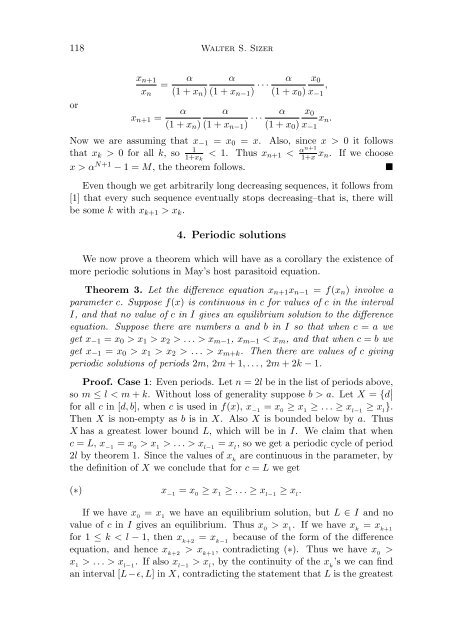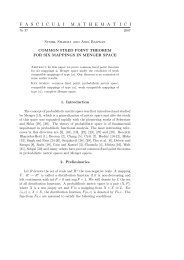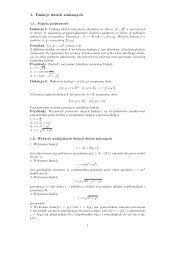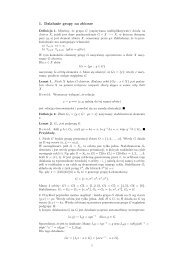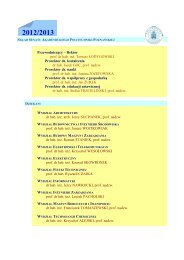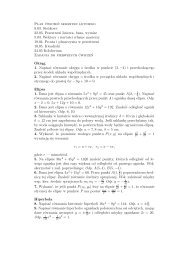F A S C I C U L I M A T H E M A T I C I
F A S C I C U L I M A T H E M A T I C I
F A S C I C U L I M A T H E M A T I C I
You also want an ePaper? Increase the reach of your titles
YUMPU automatically turns print PDFs into web optimized ePapers that Google loves.
118 Walter S. Sizerorx n+1x n=α α(1 + x n ) (1 + x n−1 ) · · · α x 0,(1 + x 0 ) x −1α αx n+1 =(1 + x n ) (1 + x n−1 ) · · · α x 0x n .(1 + x 0 ) x −1Now we are assuming that x −1 = x 0 = x. Also, since x > 0 it follows1that x k > 0 for all k, so1+x k< 1. Thus x n+1 < αn+11+x x n. If we choosex > α N+1 − 1 = M, the theorem follows.Even though we get arbitrarily long decreasing sequences, it follows from[1] that every such sequence eventually stops decreasing–that is, there willbe some k with x k+1 > x k .4. Periodic solutionsWe now prove a theorem which will have as a corollary the existence ofmore periodic solutions in May’s host parasitoid equation.Theorem 3. Let the difference equation x n+1 x n−1 = f(x n ) involve aparameter c. Suppose f(x) is continuous in c for values of c in the intervalI, and that no value of c in I gives an equilibrium solution to the differenceequation. Suppose there are numbers a and b in I so that when c = a weget x −1 = x 0 > x 1 > x 2 > . . . > x m−1 , x m−1 < x m , and that when c = b weget x −1 = x 0 > x 1 > x 2 > . . . > x m+k . Then there are values of c givingperiodic solutions of periods 2m, 2m + 1, . . . , 2m + 2k − 1.Proof. Case 1: Even periods. Let n = 2l be in the list of periods above,so m ≤ l < m + k. Without loss of generality suppose b > a. Let X = {d ∣ for all c in [d, b], when c is used in f(x), x −1= x 0≥ x 1≥ . . . ≥ x l−1≥ x l}.Then X is non-empty as b is in X. Also X is bounded below by a. ThusX has a greatest lower bound L, which will be in I. We claim that whenc = L, x −1= x 0> x 1> . . . > x l−1= x l, so we get a periodic cycle of period2l by theorem 1. Since the values of x kare continuous in the parameter, bythe definition of X we conclude that for c = L we get(∗) x −1= x 0≥ x 1≥ . . . ≥ x l−1≥ x l.If we have x 0= x 1we have an equilibrium solution, but L ∈ I and novalue of c in I gives an equilibrium. Thus x 0> x 1. If we have x k= x k+1for 1 ≤ k < l − 1, then x k+2= x k−1because of the form of the differenceequation, and hence x k+2> x k+1, contradicting (∗). Thus we have x 0>x 1> . . . > x l−1. If also x l−1> x l, by the continuity of the x k’s we can findan interval [L−ɛ, L] in X, contradicting the statement that L is the greatest


